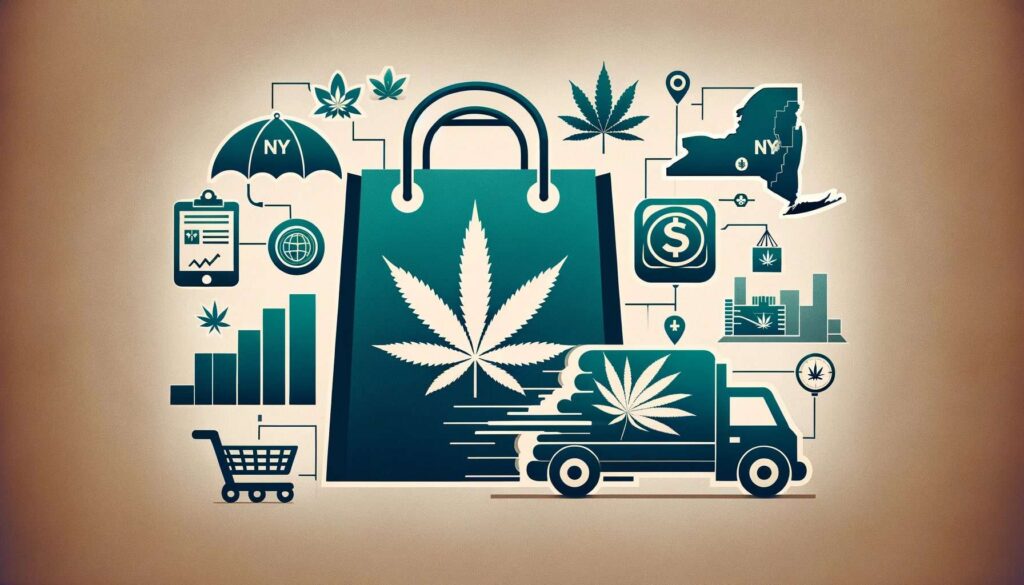- [email protected]
- (619) 304-4004
New York’s medical marijuana market is expanding, with sales projected to hit $743 million by 2025. The state issued its first 36 Conditional Adult-Use Retail Dispensary licenses in 2022, aiming for an equitable industry, with significant anticipated tax revenue benefiting local communities and drug treatment programs.
Medical Marijuana in New York

The sales and distribution of medical marijuana in New York are integral components of a rapidly evolving cannabis industry. This sector is expected to significantly impact the state’s economy, with projections indicating that marijuana sales in New York could reach approximately $743 million by 2025. Such growth opens up vast opportunities in previously underserved areas affected by prohibition.
In terms of medical cannabis, a cross-sectional analysis showed that 22.1% of census tracts in New York had at least one certifying provider, and 0.8% had a medical cannabis dispensary. The state requires businesses selling CBD products to customers in New York to obtain a Cannabinoid Hemp Retail License from the Office of Cannabis Management. This license costs $300 per site and is valid for one year.
The state has also initiated the issuance of Conditional Adult-Use Retail Dispensary (CAURD) licenses, with the first 36 being announced in late 2022. These licenses were part of New York’s approach to building an equitable and inclusive market. The licenses included 28 for business owners with a cannabis conviction or a family member with such a conviction and 8 for nonprofit organizations.
Tax revenue from the cannabis program is anticipated to be substantial, with New York State expecting to receive $20 million from licensing fees in the first year of legalization.
Once legal retail dispensaries start generating sales, the State projects $360 million in annual state revenue and $75 million for local governments. These revenues are earmarked for state drug treatment programs and communities disproportionately affected by previous cannabis legislation.
The emergence of this market underlines the importance of legal compliance and adherence to the state’s regulations to ensure the success and sustainability of the cannabis industry in New York.
The current legal framework for the sale and distribution of medical marijuana in New York is primarily based on the Marijuana Regulation and Taxation Act (MRTA), enacted on March 31, 2021. This comprehensive legislation has led to the establishment of the Office of Cannabis Management (OCM) governed by the Cannabis Control Board, responsible for regulating adult-use, medical, and hemp cannabis.
The OCM plays a crucial role in issuing licenses and developing regulations that outline business participation in New York’s cannabis industry. This includes the licensing of cultivators, processors, distributors, and dispensaries involved in growing, manufacturing, and selling adult-use, medical cannabis, and certain hemp (CBD) products.
One of the notable aspects of the MRTA is its emphasis on social justice and equitable economic development. The Act aims to correct past harms caused by cannabis prohibition, particularly in communities of color.
It has led to the expungement of nearly 400,000 cannabis-related arrests and convictions from public records. The MRTA also allows adults 21 years and older to partake in the recreational use of marijuana in places where smoking tobacco is allowed.
In terms of licensing, the first 36 Conditional Adult-Use Retail Dispensary (CAURD) licenses were issued in late 2022, focusing on promoting equity. These licenses were primarily granted to business owners with a cannabis conviction or a family member with such a conviction, and nonprofit organizations. The MRTA provides opportunities for individuals and communities previously affected by marijuana criminalization.
Additionally, municipalities in New York had the option to opt out of allowing retail marijuana dispensaries, with a total of 759 out of 1,520 municipalities choosing to opt out as of December 2021.
Businesses interested in obtaining licenses for the sale and distribution of medical marijuana in New York must navigate a comprehensive regulatory process established by the Office of Cannabis Management (OCM) under the Marijuana Regulation and Taxation Act (MRTA). This process is designed to oversee the adult-use, medical, and cannabinoid hemp industries within the state.
To apply for a license, businesses must adhere to the specific guidelines and requirements set by the OCM. The application process includes several components:
Businesses interested in applying for a license should thoroughly review the Adult-Use Cannabis Regulations and all application resources provided by the OCM. Future application windows for other license types such as nursery, delivery, cooperative, or collective, and on-site consumption are anticipated.
The criteria for obtaining licenses for the sale and distribution of medical marijuana in New York are governed by the Office of Cannabis Management (OCM) and outlined in the Marijuana Regulation and Taxation Act (MRTA). Here are the key points for businesses seeking these licenses:
For a detailed understanding of the licensing criteria and to initiate the application process, businesses should consult the resources provided by the OCM on their Licensing page and refer to Cannabis License Experts for comprehensive guidelines on the New York cannabis license application process.
The sales and distribution of medical marijuana in New York are regulated by the Office of Cannabis Management (OCM), operating under the guidelines established by the Marijuana Regulation and Taxation Act (MRTA). The MRTA, enacted on March 31, 2021, created a comprehensive regulatory structure for overseeing the licensure, cultivation, production, distribution, sale, and taxation of medical, adult-use, and cannabinoid hemp within the state.
The OCM, governed by a Cannabis Control Board, is responsible for issuing licenses and developing regulations for businesses to participate in the cannabis industry. This encompasses the complete spectrum of activities related to cannabis, including the medical marijuana sector.
The OCM also establishes quality assurance and product manufacturing standards, laboratory testing standards, and packaging and labeling requirements to ensure consumer safety and product reliability. Additionally, it implements a social and economic equity program to encourage participation from communities disproportionately harmed by previous cannabis enforcement.
Through the MRTA, New York State has shifted its approach to cannabis from a law enforcement perspective to one focused on public health, social justice, and equitable economic development. The OCM plays a pivotal role in this transition, guiding the regulatory process and ensuring compliance with state laws and policies.

In New York, the Office of Cannabis Management (OCM), established under the Marijuana Regulation and Taxation Act (MRTA), is the primary agency responsible for regulating the sales and distribution of medical marijuana.
The OCM, governed by the Cannabis Control Board, oversees the comprehensive regulation of adult-use, medical, and hemp cannabis, ensuring compliance with state laws and regulations.
The OCM administers a sophisticated quality assurance regulatory structure that includes standards for production and manufacturing, strict product testing, labeling, packaging, and advertising. These standards are designed to ensure that cannabis products are safe for consumers and are not targeted toward youth.
The regulatory process in New York is governed by Article 2 of the State Administrative Procedure Act (SAPA). This process involves the submission of a Notice of Proposed Rulemaking to the Secretary of State for publication in the New York State Register, ensuring transparency and public participation in the regulatory process.
To strengthen compliance and enforcement, Governor Kathy Hochul signed legislation that empowers the OCM and the Department of Taxation and Finance to take actions against unlicensed dispensaries and unregulated sales of cannabis.
The legislation includes provisions for assessing civil penalties, seizing untested cannabis products from unlicensed businesses, and conducting regulatory inspections. This framework aims to protect public health, support the state’s growing cannabis industry, and ensure that tax laws pertaining to the cannabis industry are fairly enforced.
The supply chain for medical marijuana in New York is managed through a structured process overseen by the Office of Cannabis Management (OCM). Health care providers who can prescribe controlled substances in New York State, are qualified to treat the patient’s condition, and complete a specific course on medical cannabis, can certify patients for medical cannabis use.
Certified patients are automatically registered with the Medical Cannabis Program, and their certification includes a registry ID. Medical cannabis dispensaries in New York have pharmacists on-site to assist patients in finding the right products for their conditions.
These dispensaries are operated by Registered Organizations (ROs) across the state, ensuring a regulated and safe supply chain for medical cannabis from cultivation to patient consumption.
In New York’s medical marijuana industry, the supply chain is a multi-stage process involving various key players:
Each step in this chain ensures that the final cannabis products are safe, legal, and effectively meet the medical needs of patients in New York.
In New York, quality control measures for the sale and distribution of medical marijuana are stringently overseen by the Office of Cannabis Management (OCM). These measures include comprehensive regulatory structures to ensure product safety and effectiveness. Licensed medical dispensaries, operated by Registered Organizations, are required to adhere to strict standards.
These standards cover the production, testing, labeling, and packaging of medical cannabis products. Pharmacists are also available on-site at these dispensaries to assist patients and ensure the proper use of medical cannabis. For detailed information on the quality control measures and regulations for medical marijuana in New York.
In New York, the safety and efficacy of medical marijuana products are ensured through rigorous regulations and quality control measures overseen by the Office of Cannabis Management (OCM).
This includes standards for production, manufacturing, product testing, labeling, and packaging. These measures are designed to make products safer for consumers and to prevent targeting youth.
Medical cannabis dispensaries in the state have pharmacists on-site to assist patients in finding appropriate products and to check for interactions with other medications. This comprehensive approach helps maintain the integrity and safety of medical cannabis products in New York.
The economic impacts of medical marijuana sales in New York are multifaceted and significant. While I don’t have the latest data post-2023, the trends leading up to and including 2023 can give us a good understanding. Here are the key economic impacts:
It’s important to note that while the economic impacts are largely positive, the state also faces challenges such as ensuring the market remains regulated and preventing illegal sales. The state monitors and manages the market dynamics through regulatory bodies to ensure compliance, public safety, and fair market competition.
New York State’s approach to regulating medical marijuana is encapsulated in the Marijuana Regulation and Taxation Act. This act is a pioneering regulatory structure that oversees the licensure, cultivation, production, distribution, sale, and taxation of medical, adult-use, and cannabinoid hemp. The framework is designed to balance social justice, public health, and economic development.
A key aspect of New York’s cannabis policy is the establishment of a robust social and economic equity program. This program actively encourages participation from communities disproportionately impacted by previous prohibition policies. By doing so, it aims to ensure equitable access and distribution of medical marijuana, which can significantly affect patient access.
The state administers a sophisticated quality assurance regulatory structure. This includes standards for production and manufacturing, strict product testing, labeling, packaging, and advertising. Such measures are crucial to ensure that medical marijuana products are safe and accessible to patients, without being targeted to youth.
New York encourages small businesses and farmers to participate in the cannabis industry. This includes the creation of microbusiness, cooperative, and delivery license types. By diversifying the types of businesses involved in the distribution of medical marijuana, the state aims to improve patient access through a variety of dispensing options.
In New York, registered patients can purchase medical cannabis products from dispensing facilities operated by registered organizations. The availability of these dispensaries across the state plays a vital role in patient access. The more widespread and accessible these dispensaries are, the easier it is for patients to obtain the medical marijuana they need.
The state’s approach to licensing, including the types of licenses available (such as cultivator, processor, distributor, retail dispensary, and microbusiness), directly impacts the medical marijuana supply chain. The efficiency and effectiveness of this system influence how quickly and reliably patients can access medical marijuana.
The Cannabis Control Board’s creation and implementation of a social and economic equity plan further emphasize the state’s commitment to diversity and equity in the cannabis industry. This plan aims to promote racial, ethnic, and gender diversity in licensing and commerce, which can have a positive effect on patient access by ensuring a wide range of providers and product options.
In summary, the sales and distribution system in New York, governed by comprehensive regulations and a focus on social justice, public health, and economic development, plays a crucial role in determining patient access to medical marijuana. The system’s effectiveness in ensuring safe, equitable, and widespread availability of medical marijuana is key to meeting the needs of patients across the state.
The sales and distribution system for medical marijuana in New York is a critical component in ensuring patient access. Governed by a comprehensive regulatory framework, it balances the needs of public health, social justice, and economic development. The system’s focus on creating equitable access through a variety of licensed businesses, including small enterprises and microbusinesses, enhances the availability of medical marijuana across the state.
The rigorous standards for product safety and quality assurance ensure that patients receive reliable and effective products. Additionally, the state’s commitment to social and economic equity in the cannabis industry not only fosters diversity but also broadens patient access to a range of products and services.
Overall, the effectiveness of New York’s sales and distribution system is pivotal in ensuring that medical marijuana is accessible, safe, and beneficial for patients in need.
Here are some resource links related to the sales and distribution system for medical marijuana in New York:

A1 Marijuana Doctors is an online platform, that connects marijuana patients to marijuana doctors in their state.

A1 Marijuana doctors is an online platform that connects medical patients to medical marijuana doctors. We offer a quick & easy way to apply for a medical marijuana card in all legal states.
Social Links
Contact Us
Quick Links
Trusted By




This website does not sell medicine nor controlled substances. It is a network of doctors & nurse practitioners, not a pharmacy / dispensary.
Copyright ©2023 A1 Marijuana Doctors. All rights reserved.